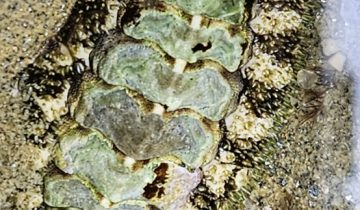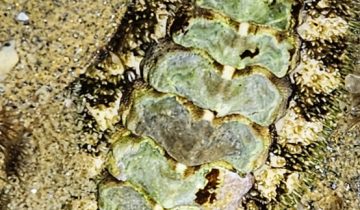Stenoplax conspicua, commonly known as the conspicuous chiton, is a species of chitons belonging to the order Chitonida and family Ischnochitonidae. Its specific name, conspicua, comes from Latin and refers to its striking appearance, especially due to the distinctive coloration in the center of its plates. This species inhabits the mid to low intertidal zones of the subtropical eastern Pacific, particularly along the coasts of Mexico and Baja California, where it is often partially hidden under pebbles and sand. It has also been reported in shallow waters down to 30 meters depth.
Stenoplax conspicua can reach a length of up to 15.4 cm, making it one of the largest chiton species in its distribution area. Its body is composed of eight articulated plates that may be gray, green, or brown, with a characteristic pinkish hue in the center of the plates, a distinguishing feature of this species. Its shape is elongated and flattened, adapted to firmly adhere to rocky substrates. It can be confused with Stenoplax limaciformis, another similar species in the same genus, but the latter has more uniform colors and lacks the central pinkish area that distinguishes Stenoplax conspicua.
Regarding its diet, Stenoplax conspicua is herbivorous, feeding mainly on microscopic algae and biofilm which it scrapes from rock surfaces using its radula, a toothed structure typical of molluscs. Its diet may include diatoms, filamentous green algae, and incrusting red algae. This feeding behavior makes it an important controller of algal biomass in its benthic ecosystem, especially in areas where organic detritus accumulates on rocky substrates.
Individuals of Stenoplax conspicua are gonochoric, meaning they have separate sexes. Fertilization is external, and reproduction occurs by releasing gametes into the marine environment, possibly influenced by lunar or tidal cycles. The eggs give rise to planktonic lecithotrophic trochophore larvae, which lack a veliger stage. These larvae swim freely for a short period before settling on the seafloor, where they undergo metamorphosis and develop into benthic juveniles. Although the exact timing of reproduction is not fully documented, many chiton species show reproductive peaks during warm seasons.
An interesting fact about Stenoplax conspicua is its habit of remaining semi-hidden under pebbles or slightly buried in sand, which, combined with its cryptic coloration, helps it avoid predators. It often shares its microhabitat with other benthic species such as small crabs, shrimps, and snails, although no specific symbiotic relationships have been documented. Its considerable size and distinctive coloration make it a striking species within the rocky intertidal zones of the eastern Pacific.
Photos:



 from
from